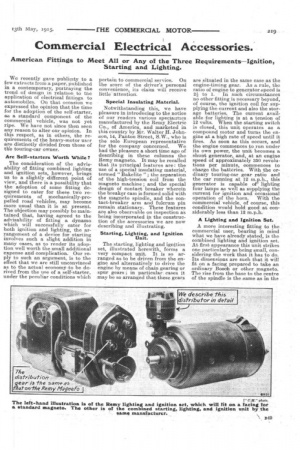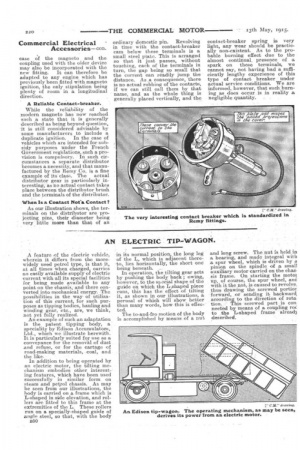Commercial Electrical Accessories.
Page 17

Page 18

If you've noticed an error in this article please click here to report it so we can fix it.
American Fittings to Meet All or Any of the Three Requirements—Ignition, Starting and Lighting.
We recently gave publicity to a few extracts from a, paper, published in a contemporary, portraying the trend of design in relation to the application of electrical fittings to automobiles. On that occasion we expressed the opinion that the time for the adoption of the self-starter, as a standard component of the commercial vehicle, was not yet ripe. We have not since then seen any reason to alter our opinion. In this respect, as in others, the requirements of the heavy-motor user are distinctly divided from those of th'e touring-car owner.
Are Self-starters Worth While ?
The consideration of the advisability of fitting combined lighting and ignition sets, however, brings us to a slightly different point of view, and there is a possibility that the adoption of some fitting designed to eater for these two requirements of mechanically-propelled road vehicles, may become more usual than it is at present. The objection may possibly be maintained that, having agreed to the advisability of fitting a dynama which will successfully cater for both ignition and lighting, the arrangement of a device for starting involves such a alight addition in many cases, as to render its adoption well worth the small additional expense and complication. Our reply to such an argument, is to the effect that we are still unconvinced as to the actual economy-to be derived from the use of a self-starter, under the peculiar conditions which pertain to commercial service. On the score of the driver's personal convenience, its claim will receive little attention.
Special Insulating Material.
Notwithstanding this, we have pleasure in introducing to the notice of our readers various specialities manufactured by the Remy Electric Co., of America, and marketed in this country by Mr. Walter H. Johnson, 14, Panton Street, S.W., who is the sole European representative for the company concerned. We had the pleasure a short time ago of describing in these columns the Remy magneto. It may be recalled that its principal features are : the use of a special insulating material, termed "Bakelite " ; the separation of the high-tension coil from the magneto machine ; and the special design of contact breaker wherein the breaker cam is formed solid with the magneto spindle, and the contact-breaker arm and fulcrum pin remain stationary. These features are also observable on inspection as being incorporated in the construction of the accessories we are now describing and illustrating.
Starting, Lighting, and Ignition Unit.
The starting, lighting and ignition set, illustrated herewith, forms a very compact unit. It is so arranged as to be driven from the engine and alternatively to drive the engine by meant; of chain gearing or spur gears ; in particular_ eases it may be so arranged that these gears
are situated in the same case as the engine-timing gear. As a rule, tho ratio of engine to generator speed is 2to 1. In such circumstances no other fitting is necessary beyond, of course, the ignition coil for supplying the current and also the storage batteries. The current available -for lighting is at a tension of 12 volts. When the starting switch is closed, this unit operates as a compound motor and turns the engine at a high rate of speed until it fires. As soon as this occurs, and the engine commences to run under its own power, the unit becomes a shunt generatOr,. and, at an engine speed of approximately 350 revolutions per minute, commences to charge the batteries. With the ordinary touring-car gear ratio and the car running at 12 m.p.h., this generator is capable or lighting four lamps as well as supplying the current for ignition and occasional operation of the horn. With the commercial vehicle, of course, this condition would hold good at considerably less than 12 m.p.h.
A Lighting and Ignition Set.
A more interesting fitting to the commercial user, bearing in mind what we have already stated, is the combined lighting and ignition set. At first appearance this unit strikes one particularly as being small, considering the work that it has to do. Its dimensions are such that it will fit on a facing prepared to take an ordinary Bosch or other magneto. The rise from the base to the centre of the spindle is the same as in the
Commercial Electrical • Accessories—con.
case of the magneto and the coupling used with the older device may also be incorporated with the new fitting. It can therefore be adapted to any engine which has Previously been fitted with magneto ignition, the only stipulation being plenty of room in a longitudinal direction.
A Reliable Contact-breaker.
While the reliability of the modern magneto has now reached such a state that it is generally described as being beyond question, .it is still considered advisable by some manufacturers to include a duplicate ignition. In the case of vehicles which are intended for subsidy purposes under the French Government regulations, such a provision is compulsory. In such circumstances a separate distributor becomes a necessity, and that manufactured by the Remy Co. is a fine example of its claw. The actual distributor gear is particularly interesting, as 'no actual contact takes place between the distributor brush and the terminals of the distributor.
When Is a Contact Not'a Contact ?
As our illustration shows, the terminals on the distributor are projecting pins, their diameter being very little more than that of an
ordinary domestic pin. Revolving in time with the contact-breaker cam below these terminals is a small steel plate. This is arranged so that it just passes, without touching, each of the terminals in turn, the gap being so small that the current can readily jump the distance. As .a consequence, there is no actual rubbing of the contacts, if we can still call them by that name, and as the whole thing is generally placed vertically, and the contact-breaker spring is very light, any wear should be practically non-existent. As to the probable burning effect due to the almost continual, presence of a spark on these terminals, we cannot say, not having had a sufficiently lengthy experience of this type of contact breaker under actual service conditions. We are informed, however, that such burning as does occur is in reality a negligible quantity.






















